Biology: Module 5 - Heredity
1/184
Earn XP
Description and Tags
HSC: Heredity
Name | Mastery | Learn | Test | Matching | Spaced |
|---|
No study sessions yet.
185 Terms
what are the five kingdoms
1. bacteria
2. protists
3. fungi
4. plants
5. animals
define reproduction
a biological process by which individual organisms (offspring) are produced from their parent or parents
why is reproduction neccesary?
A necessity for the continuity of species
If new organisms weren’t produced, species would go extinct
what is asexual reproduction and some of its features
where an organism clones itself
Only occurs in unicellular organisms
Only one parent
Genetically identical offspring
advantages of asexual reproduction
Efficient form of reproduction
Amount of time and energy to produce offspring is less
Population sizes can increase rapidly in optimal environments
No need for sexual partner
Genetically identical offspring, so well suited for stable environment
disadvantages of asexual reproduction
Rapid population growth can lead to overcrowding and increased competition
Lack of genetic variation in a population can cause death of the population if conditions change
what is binary fission
Produces two new daughter cells genetically identical to the parent
DNA needs to be replicated
Has one circular piece of DNA → replication occurs in both directions around the circle until the whole chromosome is replicated
Membrane pinches → two chromosomes move to opposite parts of the cell → new cell wall forms → bacteria replicates
why has the classification of living things changed over time
new organisms have been discovered
what is the benefit of three domain of life system
allows classification to go further and acknowledges a common ancestor
Shows how different kingdoms are related to each other
what is the benefit of the five kingdom classification
classify organisms based on their similarities and differences
what is the bacteria’s
1. cell type
2. cell wall
3. number of cells
4. mode of nutrition
5. reproduction
6. example
1. prokaryote
2. cell wall
3. unicellular
4. auto/heterotroph
5. asexual
6. salmonella
what is the protista
1. cell type
2. cell wall
3. number of cells
4. mode of nutrition
5. reproduction
6. example
1. eukaryote
2. cell walls - some have chloroplast
3. unicellular, colonial, multicellular
4. auto/heterotroph
5. a/sexual
6. euglena, algae
what is the fungi
1. cell type
2. cell wall
3. number of cells
4. mode of nutrition
5. reproduction
6. example
1. eukaryote
2. cell wall
3. multicellular
4. autotroph/decomposer
5. a/sexually
6. yeast, mushrooms
what is the plants
1. cell type
2. cell wall
3. number of cells
4. mode of nutrition
5. reproduction
6. example
1. eukaryote
2. cell wall with chloroplast
3. multicellular
4. autotrophic
5. a/sexual
6. grass, sunflower
what is the animalia
1. cell type
2. cell wall
3. number of cells
4. mode of nutrition
5. reproduction
6. example
1. eukaryote
2. no cell wall
3. multicellular
4. heterotrophic
5. human, tiger
what kingdoms participate in binary fission
bacteria - parent cell survives
protists - need to split their nucleus first, parent cell splits into two daughter cells
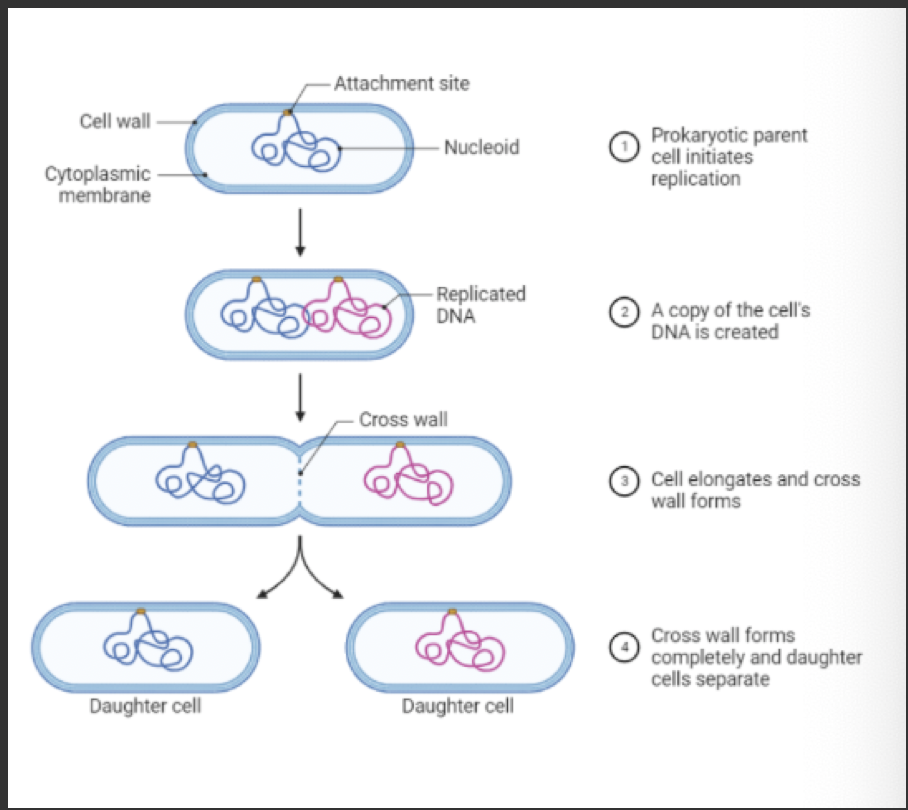
what type of reproduction is this?
asexual - binary fission
what is multiple fission
Nucleus divides repeatedly before the cell splits and then the cell splits multiple times from the parent cell to produce more than two offspring
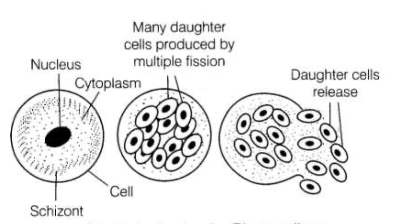
what is this reproduction?
multiple fission
who participates in multiple fission
some protists
what is budding
Asymmetrical division
Where the nucleus reproduces and smaller buds split off from the parent cell after an uneven division of the cytoplasm
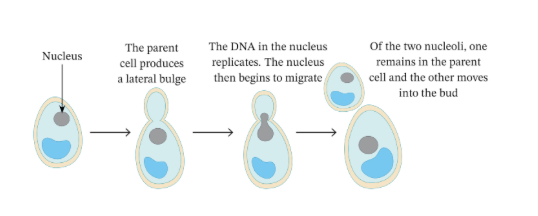
what is this type of reproduction
budding
what is fragmentation
Breaks into smaller pieces and allows regeneration of the whole organism from new pieces
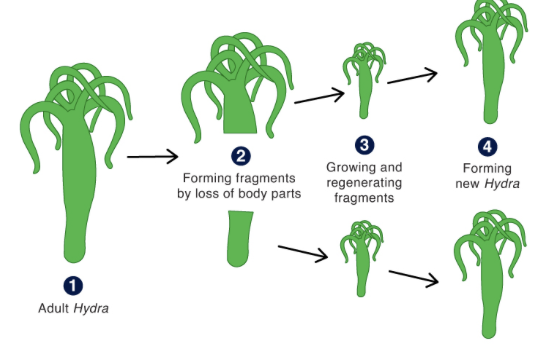
what type of reproduciton is this
fragmentation
which kingdoms participate in fragmentation
Some multiple algal protists
Animals: annelids etc.
what is a mitospore
Mitospores = reproduced asexually through mitosis
Haploid (n) reproductive cells
Capable of developing into an adult without fusion with another cell
Due to the parent organism being haploid
what is the benefit of spores as reproduction
Allow fungi to expand their distribution and colonise new environments
where are spores released from?
Released from the parent thallus: from outside or in a sporangium

what reproduction is this?
spores
what kingdoms uses spores to reproduce?
fungi, plants
what is parthenogenesis
The development of an egg in the absence of fertilisation
Can only occur in females
E.g. reptiles, birds, insects, nematodes…
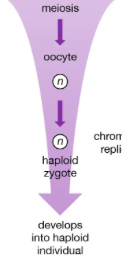
what is this reproduction
parthenogenesis
which kingdoms participate in parthenogenesis
animals
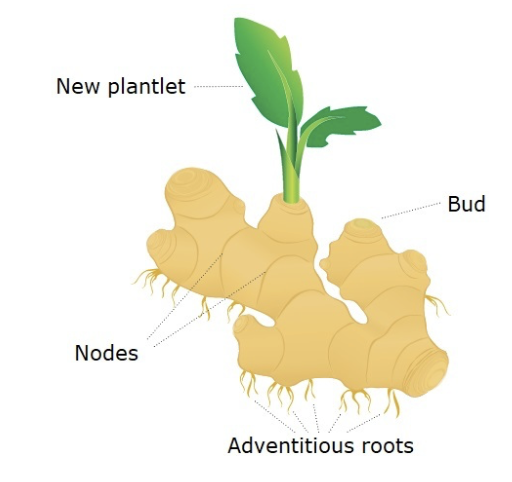
what is rhizomes and an example
Root-like stems that grow horizontally under the ground. New shoots and roots form at the nodes, with shoots growing upwards to form new plantlets
Lateral buds grow out to form new rhizomes
E.g. ginger, irises, couch grass
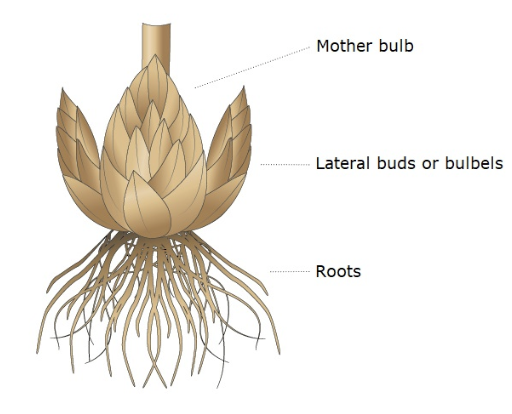
what is a bulb and an example
Form lateral buds from the base of the mother bulb, which produces new smaller bulbs or bulbels
E.g. onions
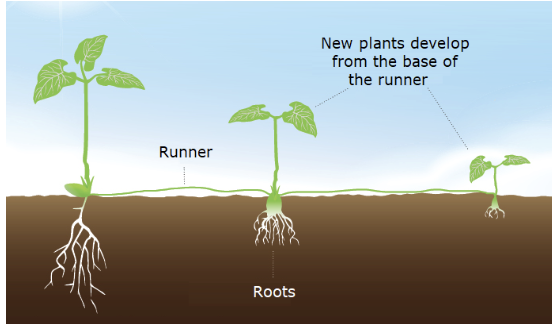
what is stolons or runners and an example
Horizontal stems that grow above the ground
Tiny plantlets form along the stolon, and roots form where they touch the ground
When the connection with the parent breaks, the new plant becomes independent
E.g. strawberries
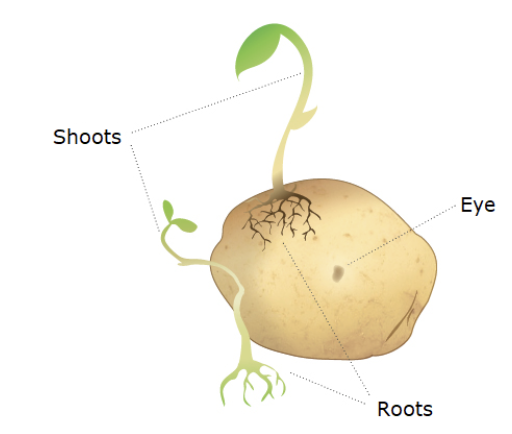
what are tubers and an example?
Tubers = Swollen portions of an underground stem that store food so a plant can lie dormant over the winter
Axillary buds (eyes) form over the surface of the tuber and produce shoots that grow into a new plant the following year
E.g. potato
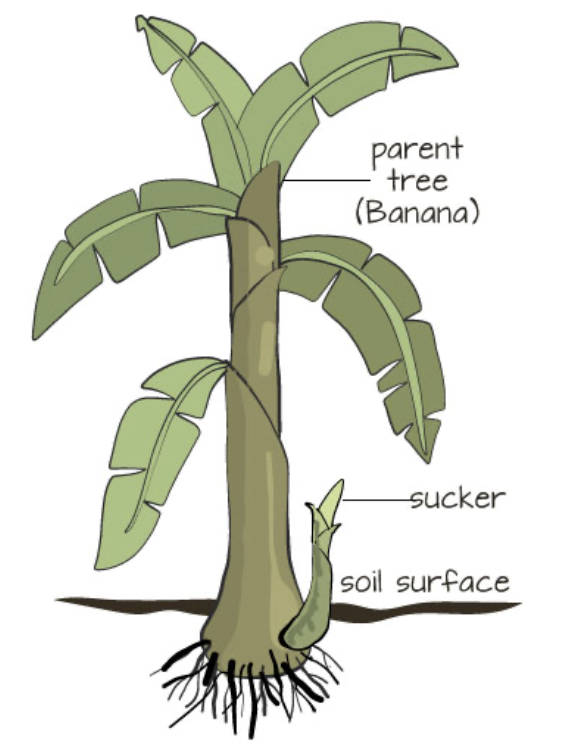
what are suckers and an example?
New shoots that arise from the roots
E.g. bananas, wattle tree
what is natural vegetative propagation
an asexual reproductive method used by plants
The growth of specialised plant tissues that can grow into a new plant if separated from the parent
Doesn’t use seeds or spores
what are advantages and disadvantages of natural vegetative propagation
Advantages: It can produce a rapid increase in the number of plants growing in a favourable area to outcompete other species
Disadvantages:
competition from sister and parent plants for resources (intraspecific competition)
Lack of genetic variation to protect population from disease and environmental changes
what is artificial reproduction
results in features of desirable plants that have been preserved from generations for commerical quantities
give three examples of artifical reproduction and a little description
Cuttings: a piece has been cut off a mother plant then caused to grown into a new plant sometimes through hormones that encourage new roots
Grafting and Budding: joining a stem piece or a single bud into a stem of a plant that has roots
The stem piece (scion) and the plant with roots (rootstock)
Tissue Culture: tiny fragments of plants are treated with plant hormones in a sterile environment to stimulate the growth of a callus for new seedlings to grow
Used to produce large number of identical seedlings
what is sexual reproduction
a combination of gametes to form a zygote
what are the advantages of sexual reproduction
Fertilisation is less risky and the young are more likely to survive
Unfavourable genetic variation is eliminated from population effectively
Generates genetic variation during meiosis
Populations can adapt to changing conditions
Improves evolution of the species
what are the disadvantages of sexual reproduction
Slower reproductive rate
Mates have to be found and accepted
Potential for sexually transmitted diseases
Uses a lot of energy
what are meiospores
Sexual Reproduction of Spores = meiospores
how are meiospores produced?
2 haploid (n) cells fuse together → where two haploid nuclei coexist (plasmogamy)
Haploid nuclei fuses together to create 1 diploid (2n) nucleus (karyogamy)
Gametes of different mating types are produced → spores are disseminated into the environment (meiosis)
what is conjugation
Two individuals fuse and exchange genetic material

what reproduction is this
conjugation
how does angiosperms pollinate?
male pollen lands on female stigma —> tube grow to petrate surface of stigma > pollen tube carries two sperm cells to reach the ovule —> egg fuses with one sperm to form 2n cell/embryo —> other sperm combines with tissue to nourish embryo—. ovule develops into seed, leaves,roots, tissues —> ovary becomes matured fruit —> embryos lie in seeds until conditions are right to germinate
where does the male gametophyte stay and what is it
the pollen grain which contains sperm celles hled on the anther at the top of the stamen
what is the female gametophyte and where is it
the embryo sac that contains the egg held in an ovule in the plant’s ovary
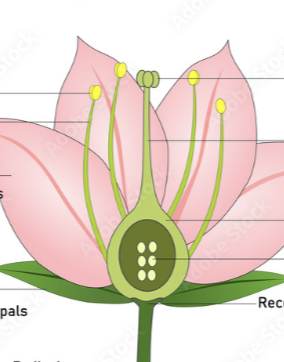
label diagram
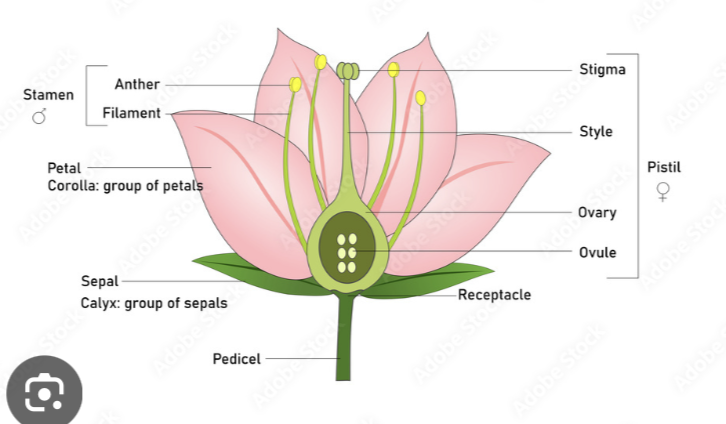
how do bryophytes reproduce?
Have a reproductive structure that produces gametes in a specialised structure (gametophytes)
Asexually reproduces through fragmentation, budding
Sexually reproduces through releasing sperm from antheridin to swim in the egg
Spores are produces and dispersed to form new gametophytes
how do ferns reproduce
Reproduce sexually through spores
Spores released from underside of the fronds and develop into gametophytes, to produce sperms and eggs
Sperm swims to egg to form new sporophyte
how do gymnosperms reproduce
Have male and female cones
Pollen is released from microsporangium to reach the female cone (sex organ)
Male gametes get discharged and the male and female gametes fuse, fertilising to form an embryo and the ovule forms a seed
what is external fertilisation
When a male’s sperm fertilises a female’s egg outside of the female’s body
examples of external fertilisation
E.g. female frog releases unfertilised eggs in water → male frog latches unto the back of the female → releases sperm into water → latching on the female ensures eggs and gametes are more likely to unite
E.g. salmon, cod, frogs, aquatic invertebrate
advantages of external fertilisation
More rapid and with larger quantities
Female can continue to reproduce without waiting for the first young to develop
Parents don’t spend energy for gestation and caring for the young
Young are widely dispersed, reducing competition
disadvantages of external fertilisation
More gametes need to be produced
No control over the gametes once released
Decreased chance of successful fertilisation - unless synchronised release of gametes
Young usually need to fend for themselves
Must take place in aquatic environment - otherwise gametes would dehydrate and can’t move
Gametes and zygotes are exposed to predation, disease, environmental changes
what is internal fertilisation
When the male transfers his gametes directly into the female’s body through a tube in his penis
The gamete union occurs within the body of the parent
The chromosomes in the sperm pair with the egg’s to form a diploid zygote cell
The development of the zygote continues internally through mitosis, inside the females (mammals) or externally inside a shelled egg fed by yolk
All terrestrial animals and some aquatic animals undergo internal fertilisation
what are advantages of internal fertilisation
Can take place on dry land - the reproductive tract is always moist
Less gametes have to be produced
More likely to be successful because gametes are positioned close together in the tract
Gametes and zygotes are protected from predation and diseases
Developing young are fed and protected increasing their chance of survival
what are disadvantages of internal fertilisation
Usually slower with fewer progeny
Mating rituals and practices are more complex to reach sex
Potential for STD through population
Uses a lot of energy input
Parental care of young may be lengthy
what is a placental mammal and e.g
Have a longer gestation period
Give birth to a developed young
Humans, horses, dogs, mice, seals
what is a marsupial mammal and e.g
Give birth to underdeveloped live young
Placed in a pouch to develop further
Kangaroo, brushtail possum, wombat, koala
what is a monotreme and an e.g.
Lay eggs, oviparous
The young develop in the eggs
Platypus, echidna
where are male gametes held in humans
Paired testes are held inside the scrotum which produces and stores mature sperm continuously
Seminiferous tubules where sperm cells are formed
Epididymis stores the sperm cells
what is the purpose of the flagellum of a sperm
Have a flagellum to propel them through the female reproductive system towards the egg after copulation
when does spermatogenesis start?
during puberty and often continues throughout his life

what is this?
spermatogenesis
what does Luteinising hormone (LH) do in males?
from the pituitary gland in the brain stimulates the secretion of testosterone in the testes
what is the uterus
where the fertilised egg goes to be implanted
what do the ovaries hold
oocytes (immature egg cells) until puberty and ovulation
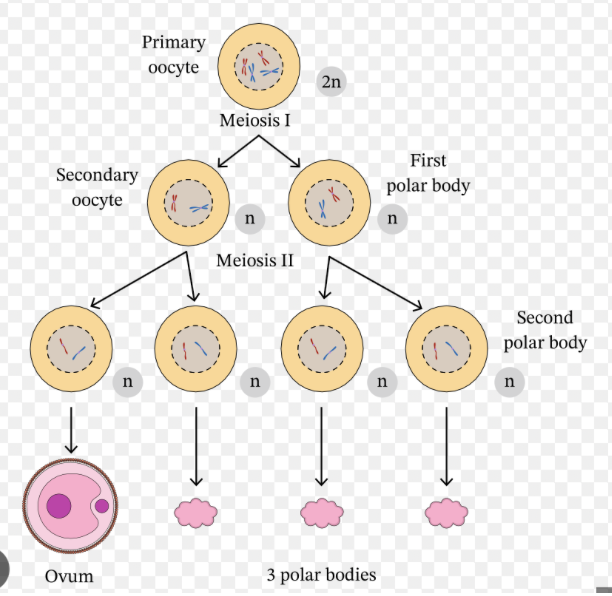
what is the production of ova (oogenesis)
starts during foetal development —> is arrested during prophase I —> During puberty, the ovarian cycles commence again, the pituitary hormones control the continuation and completion of meiosis I —> Meiosis II occurs, but is arrested until actual fertilisation occurs, and only continues once the egg is fertilised
four phases of ovulation
1. follicular
2. ovulation
3. luteal phase
4. menstruation
what is the follicular phase
FSH (follicle stimulating hormone) is secreted from anterior pituitary gland
Stimulates growth in ovarian follicles
The dominant follicle produces oestrogen: inhibits FSH secretion to → prevent other follicle growth
Oestrogen begins to stimulate the thickening of the endometrium in the uterus for implantation
what is ovulation
Oestrogen → stimulates anterior pituitary gland to secrete hormones → surge of luteinizing hormone (LH) → decrease in FSH
LH causes dominant follicle to rupture and release a secondary oocyte ovulation
what is luteal phase
Ruptured follicle develops into slowly degenerating structure called corpus luteum
Secrete high levels of progesterone, lower levels of oestrogen → thicken endometrium → inhibit FSH and LH
what is menstruation
If fertilisation occurs, developing embryo will implant in the endometrium and release hormones to sustain corpus luteum
If not, corpus luteum degenerates → oestrogen and progesterone levels drop → endometrium is eliminated as menstrual blood
Another cycle begins → FSH rises
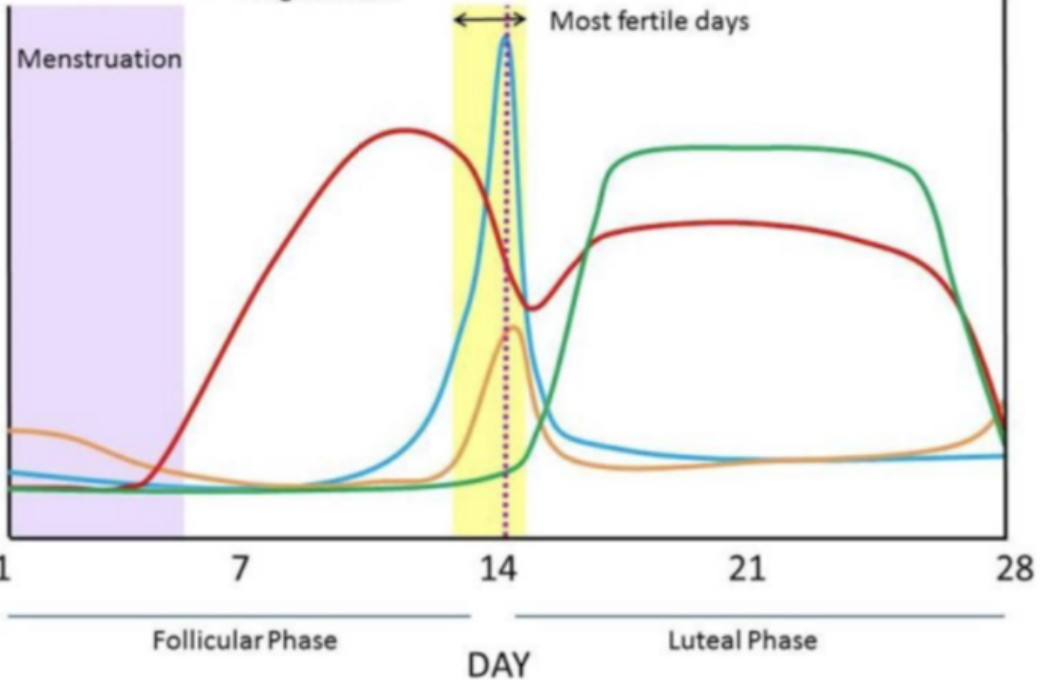
what are the hormones associated with each colour?
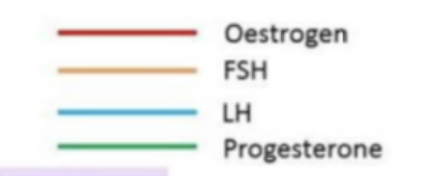
define fertilisation
the fusion of two haploid (n) gametes to form a single diploid (2n) zygote cell
There are equal genetic contributions front he male and female for the zygote
what is the fertilisation event (5 steps)
Sperm injected into vagina, where it swims through the cervix to into the oviduct
Sperm uses enzymes to dissolve the protective layer around the egg to reach the cell membrane
The sperm binds to specialised proteins on the egg’s cell membrane to ensure that a sperm of the species fertilises the egg → its nucleus enters the cytoplasm
The egg’s surface changes to prevent multiple sperm nuclei from entering the egg
Fusion of the haploid egg and sperm nuclei result in a diploid zygote cell
what is implantation
The zygote travels down the oviduct to reach the uterus
The embryo has started with cleavage → and once it reaches the uterus ready for implantation it is a blastocyst (ball of cells)
what are the steps the zygote goes through to become gastrula
Cleavage: the single celled zygote is divided into hundreds of smaller cells by mitosis
Morula: embryo continues to divide, until a few days later it has 16 cells as it enters the uterus. It has unspecialised embryonic stem cells
Blastocyst: it still divides and becomes a blastocysts as the cells begin to differentiate, and by day 8 or 9 it implants to the wall of the uterus
The outer layer of cells sends out projections into the endometrium that develops into the placenta
Gastrula: occurs over five days, where the blastocyst becomes a gastrula that has three different layers of cells → becomes embryo → foetus.
what is the placenta
outer layer cells of blastocyst form placenta - an exchange organ that brings foetus’ blood vessels in close contact with the mum’s without it being directly exchanged
- nutrients and waste diffuse across
what is FSH and where is it secreted from?
Follicle Stimulating Hormone (FSH)
Anterior pituitary
Promotes development of follicle and secretion of oestrogen
what is LH and where is it secreted from?
Luteinising Hormone (LH)
Anterior Pituitary
• Promotes ovulation
• development of corpus luteum
• secretion of progesterone
what is prolactin and where is it secreted from
Prolactin
Anterior Pituitary
• stimulates milk secretion
what is oestrogen and where is it secreted from
Oestrogen
Corpus luteum then placenta
• Develops placenta, foetal organs
• Promotes menstrual cycle
• Maintains uterine lining
• Increases blood flow to uterus and placenta
• Suppresses LH and FSH production
what is progesterone and where is it secreted form
Progesterone
Corpus luteum (for 6 weeks) then placenta
• Thickens endometrium to allow implantation
• Supports pregnancy
• Suppress contractions and lactation from preterm labour
what is oxytocin and where is it secreted from
Oxytocin
Posterior pituitary
• Helps contractions to occur
what is hcg and where is it secreted from
Human chorionic gonadotropin (hCG)
Placenta
• Maintains corpus luteum for it to produce progesterone to prevent menstruation
• Thickens endometrium
• Stimulates production of blood vessels in uterus
• Regulates ovarian hormones
what is relaxin and where is it secreted from
Relaxin
Ovary and placenta
• Relaxes ligaments in pelvis and widens cervix for childbirth
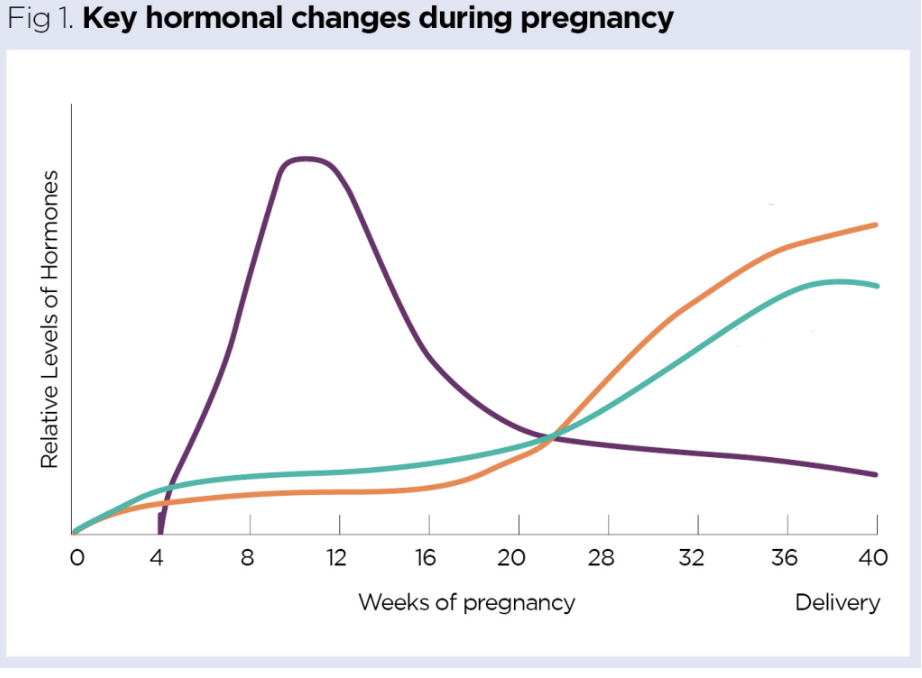
what are the hormones associated with these colours: hcg, oestrogen, progesterone
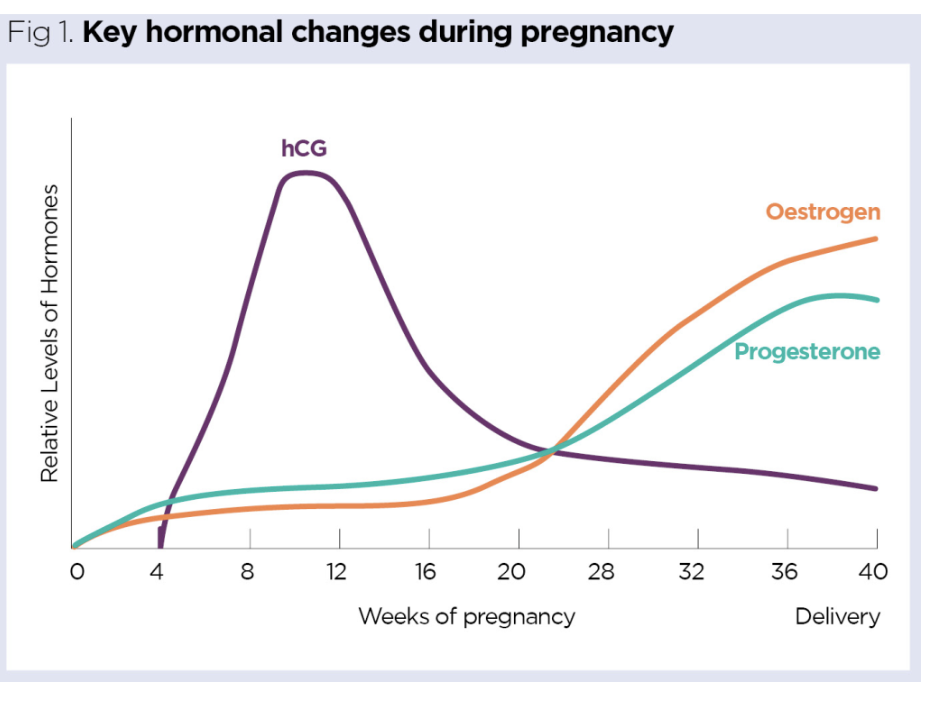
selective breeding is
humans manipulate gene pools of populations through deliberate selection of individuals for breeding
what is the process of selective breeding
Determine the desired trait
Interbreed parents who show desired trait
Select offspring with best form of the desired trait and interbreed them
Continue process until population reliably reproduces desired traits
what is gene linkage
When not just the desired trait is selected for - can be inadvertently selected
Genes that are located close together on a chromosome are said to be linked
Those genes usually stay together and are inherited
E.g. Silver Fox = the genes related with “tameness” are carried on chromosomes linked with their ears, tails and colour of fur
why is selective breeding done in plants
This is usually done to producing higher-quality food
Results in larger, nutritious or more aesthetically pleasing food
examples of selective breeding in plants
E.g. tomato, cereals, potato, wheat
Maize was bred from a wild grass called teosinte - modern maize has larger cobs with more rows or larger kernels
what is polyploidy
A condition where the cell nucleus has more than two sets of chromosomes where the genome is 3n or more
Can occur naturally through errors in meiosis
Gamete is 2n rather than n